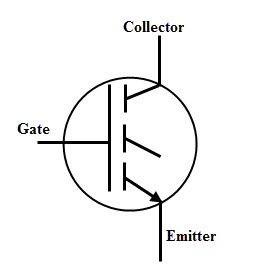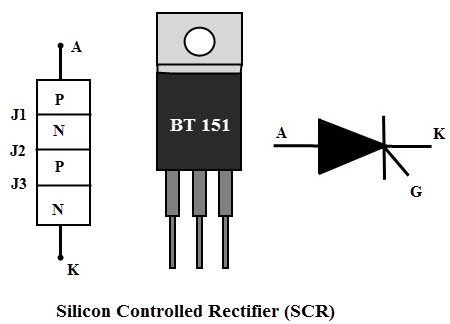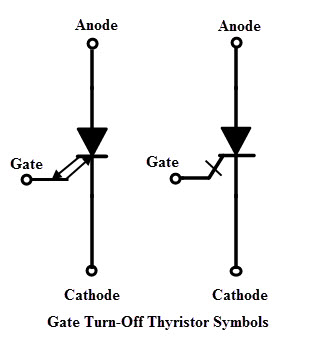Electronic Switches :
The electronic switches are generally called as solid state switches because there are no physical moving parts and hence absence of physical contacts. Most of the appliances are controlled by semiconductor switches such as motor drives and HVAC equipments.
There are different types of solid state switches are available in today market with different sizes and ratings. Some of these solid state switches include transistors, SCRs, MOSFETs, TRIACs and IGBTs.
Bipolar Transistors :
A transistor either allows the current to pass or it blocks the current as similar to working of normal switch.
In switching circuits, transistor operates in cut-off mode for OFF or current blocking condition and in saturation mode for ON condition. The active region of the transistor is not used for switching applications.
Both NPN and PNP transistors are operated or switched ON when a sufficient base current is supplied to it. When a small current flows though the base terminal supplied by a driving circuit (connected between the base and emitter), it causes to turns ON the collector-emitter path.
And it is turned OFF when the base current is removed and base voltage is reduced to a slight negative value. Even though it utilizes small base current, it is capable to carry much higher currents through the collector- emitter path.
Power Diode :
A diode can perform switching operations between its high and low state impedance states. Semiconductor materials like silicon and germanium are used for constructing the diodes.
Usually, power diodes are constructed using silicon in order to operate the device at higher currents and higher junction temperatures. These are constructed by joining p and n type semiconductor materials together to form PN junction. It has two terminals namely anode and cathode.
When the anode is made positive with respect to cathode and by the application of voltage greater than the threshold level, PN junction is forward biased and starts conducting (like ON switch). When the cathode terminal is made positive with respect to anode, PN junction reverse biased and its blocks the current flow (like OFF switch).
MOSFET :
Metal Oxide Semiconductor Field Effect Transistor (MOSFET) is a unipolar and high frequency switching device. It is a most commonly used switching device is power electronic applications. It has three terminals namely drain (output), source (common) and gate (input).
It is a voltage controlled device, i.e., by controlling input (gate to source) voltage, resistance between the drain and source is controlled which further determines the ON and OFF state of the device.
MOSFETs can be a P-channel or N-channel devices. The N-channel MOSFET is tuned ON by applying a positive VGS with respect to the source (provided that VGS should be greater than threshold voltage).
P-channel MOSFET operates in a similar manner of N-channel MOSFET but it uses reverse polarity of voltages. Both VGS and VDD are negative with respect the source to switch ON the P- channel MOSFET.
IGBT :
IGBT (Insulated Gate Bipolar Transistor) combines the several advantages of bipolar junction power transistor and power MOSFET. Like a MOSFET, it is a voltage controlled device and has lower ON state voltage drop (less than that of MOSFET and closer to power transistor).
It is a three terminal semiconductor high speed switching device. These terminals are emitter, collector and gate.
Similar to the MOSFET, IGBT can be turned ON by applying a positive voltage (greater than the threshold voltage) between the gate and emitter. IGBT can be turned by reducing the voltage across the gate-emitter to zero. In most of the case it needs negative voltage to reduce turn OFF losses and safely turn OFF the IGBT.
SCR :
A Silicon Controlled Rectifier (SCR) most widely used high speed switching device for power control applications. It is a unidirectional device as a diode, consisting of three terminals, namely anode, cathode and gate.
An SCR is turned ON and OFF by controlling its gate input and biasing conditions of the anode and cathode terminals. SCR consists of four layers of alternate P and N layers such that boundaries of each layer forms junctions J1, J2 and J3.
TRIAC :
TRICE (or TRIode AC) switch is a bidirectional switching device which is an equivalent circuit of two back to back SCRs connection with one gate terminal.
Its capability to control AC power in both positive and negative peaks of the voltage waveform often makes these devices to be used in motor speed controllers, light dimmers, pressure control systems, motor drives and other AC control equipments.
DIAC :
A DIAC (or DIode AC switch) is bidirectional switching device and it consists of two terminals which are not named as anode and cathode. It means that a DIAC can be operated in either direction regardless of the terminal identification. This indicates that the DIAC can be used in either direction.
When a voltage is applied across a DIAC, it either operates in forward blocking or reverse blocking mode unless the applied voltage is less than the breakover voltage. Once the voltage is increased more than breakover voltage, avalanche breakover occurs and device starts conducting.
Gate Turn-Off Thyristor :
A GTO (Gate Trun -Off Thyristor) is a bipolar semiconductor switching device. It has three terminals as anode, cathode and gate. As the name implies, this switching device is capable to turn OFF through gate terminal.
A GTO is turned ON by applying a small positive gate current triggers the conduction mode and turned OFF by a negative pulse to the gate. GTO symbol consists of double arrows on the gate terminal which represents the bidirectional flow of current through gate terminal.
Related Post :
What is electrical switches & their types?
What is electrical switches & their types?





Comments
Post a Comment
Do not enter any spam link in the comment box.